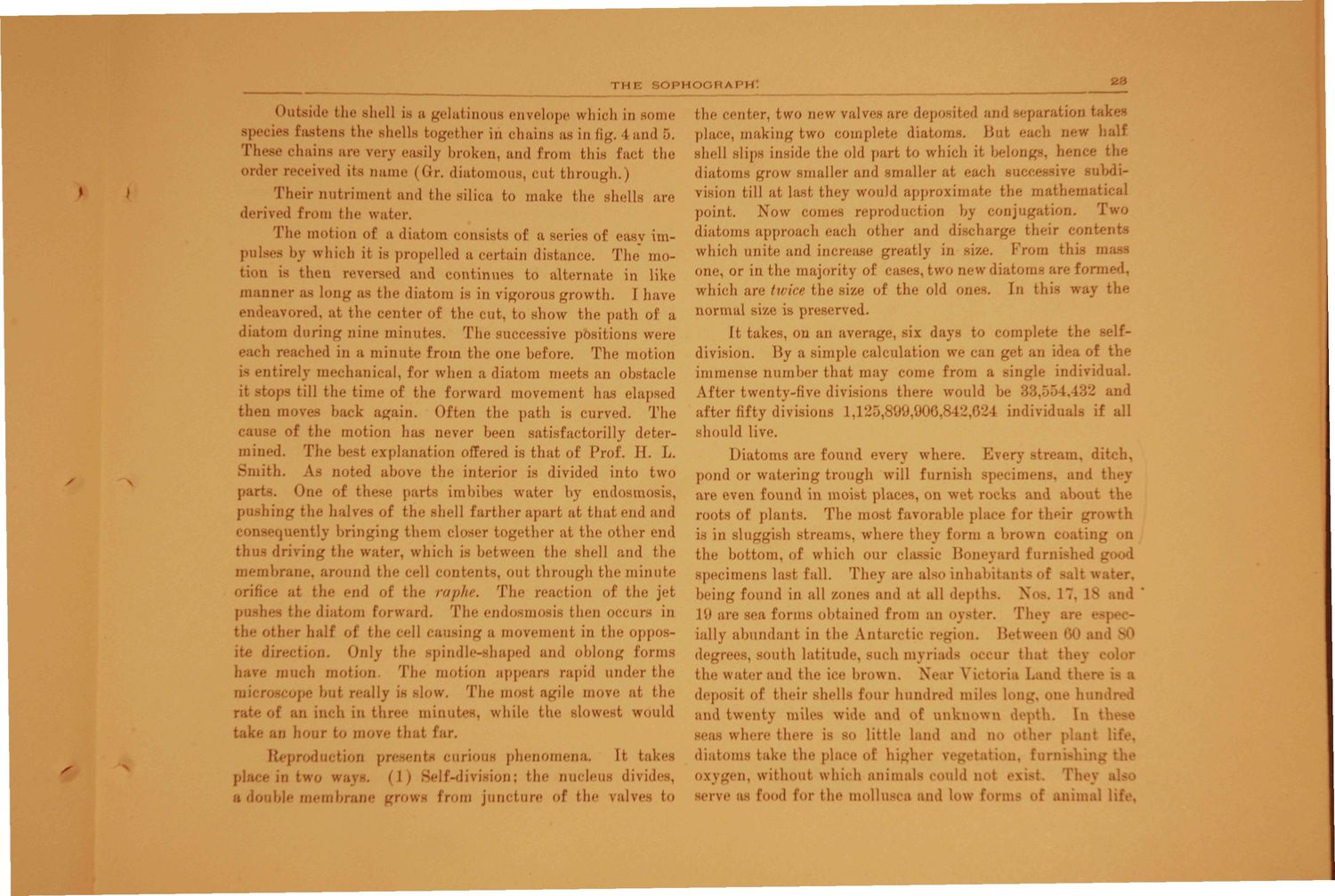Caption: Sophograph - 1890
This is a reduced-resolution page image for fast online browsing.

EXTRACTED TEXT FROM PAGE:
TNI OPH •GRAPH: » the Bhell is a gelatinous envelop.' which in some species fastens the shells together in chains as in fig. 4and 5. Tli haina are v.-ry easily broken, and from this fact the order received its name ((Jr. diatomous, cut t h r o u g h . ) Their nutriment and the silica to make the shells are derived from the water. T h e motion of a diatom consists of a series of easy impul 3 by which it is propelled a certain distance. Tin' motion is then reversed and continues to alternate in like m a n n e r as long as the diatom is in vigorous g r o w t h . I have ()l the center, two new valves are dep< nd separation tal i place, m a k i n g two complete diatoms. But each m half shell slips inside the old part to which it belongs, hence the diatoms grow smaller and smaller at each SUCCessil ivision till at last they would approximate the mathemati 1 point. Now comes reproduction by conjugation. IW O diatoms approach each other and d barge th«-ir c o n t e n t s which unite and increase greatly in size, from th DlflSS one, or in the majority of cases, two new diatom- are formed. which are twice the size of the old ones. In this y the endeavored, at the center of tin* cut, to show the path of a liatom during nine minutes. The successive positions were each reached in a minute from the one before. The motion is entirely mechanical, for when a diatom meets an obstacle it stops till the time of the forward movement has elapsed t h e n mo\ back again. Often the path is curved. T h e cause of the motion has never been satisfactorily determined. T h e best explanation offered is t h a t of Prof. II. L. Smith. As noted above the interior is divide.1 into two parts. One of the parts imbibes water by enilosmosis, p o s h i n g the ha] of fch< hell farther apart at t h a t end and normal size is pn rved. It takes, on an average, six days to complete the selfdivision. By a simple calculation we can get an idea of the immense number that may come from a single individual. JLfter twenty-five divisions there would be 4,432 ami after fifty divisions 1,125,899,906,842 i\ individuals if all should live. Diatoms are found every where. Every s t r e a m , ditch, pond or watering trough will furnish 8] imens, and t h e y are even found in moist places, on wet rocks ami al ,' t h e roots of plants. T h e most favorable place for their g r o w t h is in sluggish streams, where they form a brown I \\\i on nsequently bringing them closer together at the other end bus driving the water, which is between the shell and the membrane, around the cell contents, out through the minute riti at the end of the raphe. T h e reaction of the jet p 'ies the diatom forward. T h e emlosmosis then 0 - in ti r half of the cell causing a movement in the opposite dil on. Only the spindle-shaped and oblong form m 1 motion ) The motion appears rapid under the the bottom, of which our classic Boneyard irnished pecimens last fall. They are also inhabitants of salt « being found in all zones and at all depti NTos, 1~. I s r, nd 1.) are sea forms obtained from an oyster. ially abundant in the Antarctic region. ( They are Bet? I 60 and SO degrees, south latitude, u h myriads < ur that they In microscope but reallj low. The mt agile move at the would It takes the water and the ice brown. Near \ ria Land t h e n deposit of their shells four hundred miles long, one hi r; of an inch in tin minuitall an hour move t h a t far. f'eprodi ion while the slow- and twenty miles wide ami of unknown depth. seas where t here is so little land and DO r ] pn entfl curious phenomena, diatoms take the plai of higher veg ild not i, raiahuig the Ti a pis in ti w . (1) Self-division; the nucleus divides, a ible membrane grow- from juncture "f the valves to oxygen, without which animals i serve as food for the molhi and low forn of iiimal li
|